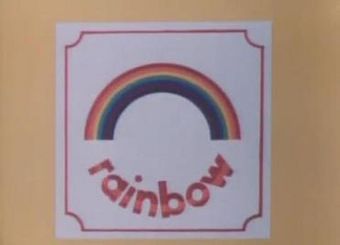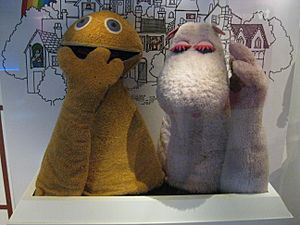Rainbow (TV series) facts for kids
Quick facts for kids Rainbow |
|
|---|---|
 |
|
| Genre | Educational |
| Created by | Pamela Lonsdale |
| Presented by | David Cook Geoffrey Hayes |
| Starring |
|
| Country of origin | United Kingdom |
| No. of series | 23 |
| No. of episodes | 1,002 |
| Production | |
| Production location(s) | Thames Studios |
| Running time | Typically about 15 minutes (though specials were 10 minutes longer) |
| Production company(s) |
|
| Distributor |
|
| Release | |
| Original network | ITV Network CITV |
| Picture format | 4:3 |
| Original release | 12 November 1972 – 31 December 1992 |
Rainbow was a popular British children's television series that first aired on 12 November 1972. Created by Pamela Lonsdale, the show ran for many years, ending its original run on 31 December 1992. It was later brought back for a few more years, from 1994 to 1997, with some changes to the cast and format.
The idea for Rainbow was to create a British version of the famous American educational show Sesame Street. Its main goal was to help young children develop language and social skills. The show was very successful, even winning an award in 1975 for Best Children's Programme. It was shown on the ITV network and became a beloved part of many children's lives.
Contents
Exploring the Rainbow House
Each episode of Rainbow took place in the "Rainbow House," where the main characters lived. The stories often focused on a specific activity or situation that happened there. In the early years, the show was very educational. It featured characters learning about a topic, mixed with real-world videos, songs, stories, and animations.
The puppet characters, Zippy, George, and Bungle, acted like curious children. The presenter, first David Cook and later Geoffrey Hayes, was like a teacher. He would help the puppets understand the topic of the day. As the show went on, especially in the 1980s, episodes became more story-driven. They often showed Zippy, George, and Bungle getting into little arguments, with Geoffrey trying to keep the peace.
The show also included songs, often performed by Rod, Jane and Freddy. There were also animated drawings and stories read from the Rainbow storybook. Some episodes focused on specific ideas like sounds or opposites, using short sketches to teach these concepts.
The Catchy Theme Song
The famous Rainbow theme song is actually a short part of a longer song. It was written by Hugh Portnow, Lady Hornsbrie, Hugh Fraser, and Tim Thomas from the band Telltale. This band also appeared regularly in the first few seasons of the show.
Even after Telltale left the show in 1974, their recording of the theme song continued to be used until the very end of the original series in 1992. Over the years, several dance versions of the theme song have been released as singles, showing how popular and memorable the tune remained.
Meet the Rainbow Characters

Rainbow was known for its unique and memorable characters:
- The presenter – The main human character was first David Cook. In 1974, he was replaced by Geoffrey Hayes, who became the most well-known presenter. Geoffrey was like a wise adult or teacher figure. He would guide the puppet characters and often tried to calm them down when they were misbehaving. While usually cheerful, Geoffrey sometimes got a bit annoyed by the puppets' antics, which added to the show's humor.
- Zippy – Zippy was a loud and often bossy character, but usually very funny. He was voiced by Roy Skelton and operated by Ronnie Le Drew. Zippy's mouth was a zip. When he became too annoying, his zip would be closed to make him stop talking. Zippy often showed off, bragging about how smart he was or how well he could sing, even though it wasn't true. He also loved sweets and chocolate.
- George – George was a shy, pink hippo. He was voiced by Roy Skelton and operated by Malcolm Lord, Tony Holtham, and later Craig Crane. George first appeared in 1973. At first, he was very timid and rarely spoke. Over time, he became more outgoing but remained mostly shy. George was usually well-behaved and kind. He often found himself caught between Zippy and Bungle's arguments.
- Bungle – Bungle was a large, furry brown bear costume. He was played by different actors, including John Leeson, Stanley Bates, and Malcolm Lord. Bungle was curious but also a bit clumsy and often complained about Zippy. He seemed sensible but could also be sneaky. The differences between Zippy and Bungle's personalities created a lot of humor in the show.
- Rod, Jane and Freddy – This was a group of musicians who regularly performed songs on the show. When they first joined in 1974, the group was 'Rod, Jane and Matt' (Matt being Matthew Corbett). Matt was later replaced by Roger Walker, and then by Freddy Marks in 1983. They were very respected by Zippy, George, and Bungle, who admired their singing.
- Other characters – Over the years, other characters appeared on the show. These included Sunshine and Moony, who were early characters, and different singing trios like Charlie Dore, Julian Littman, and Karl Johnson. Zippy's cousin Zippo, George's friend Georgette, and neighbors like Dawn and Aunty also made appearances.
Zippy and George often represented two different types of children. George was the quiet and shy type, while Zippy was more energetic and sometimes mischievous. Bungle, being a costume rather than a puppet, was seen as an older child. Geoffrey acted as a mentor or carer for all of them.
Where to Watch Reruns
If you want to watch old episodes of Rainbow, you might be able to find them! Episodes from the early 1980s were sometimes shown on the UK satellite TV channel Nick Jr. in the late 2000s. Before that, episodes were also repeated on UK Gold (now Gold) from 1992 to 1994.

